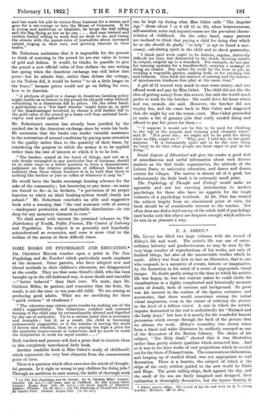Psychology and the Teacher' which particularly needs emphasis at the
moment. Some parents, who have adopted new and liberal methods in their children's education, are disappointed at the results. They see that some friend's child, who has been brought up in the old-fashioned way, is more docile and tractable —" better behaved" than their own. We must, says Dr.
Crichton Miller, be patient, and remember that the fruit, the result, is not the nine- or ten-year-old child. We are aiming at producing good adults. What are we sacrificing for these "quick returns" of obedience ?
"The educator may obtain great results by making use of the child's suggestibility. The behaviour, conduct and outward bearing of the child may be extraordinarily altered and dignified by the use of authority. Up to a certain point this is necessary and desirable ; but if, as a result, the child is becoming permanently suggestible, or if the teacher is sowing the seeds of heresy and rebellion, then he is paying too high a price for the apparent improvement in behaviour, and he needs to resist the temptation to work for rapid results. . . ."
Both teachers and parents will find a great deal to interest them in this completely untechnical little book.
Another readable book is Miss Cabot's study. of childhood', which represents the very best elements from the commonsense
point of view.
There is a question which often exercises the minds of thought- ful parents. Is it.right or wrong to pay children for doing jobs ? Through an ambition to earn money, the habit of thorough work
• (1) The New Psychology and the Teacher. By H. Crichton Miller. London : Jarrolds. [6s. net.)—(2) Seven Ages of Childhood. By Ella Lyman Cabot. London : Megan Paul. (12s. ed. net.]—(3) Social Aspects of Education. Landon: Pitmans. Ns sa. net.]—.-(4) The Poe-aglow of Thought and Fccan7. . By Charles Platt. London: Kegan Paul. 178. ed. net.) can be kept up during what Miss Cabot calls "The Angular Age" (from about 7 or 8 till 11 or 12), when boisterousness, self-assertion, noise and inquisitiveness are the prevalent charac- teristics of childhood. On the other hand, many parents are 'inclined to think that paying a child for doing that which he or she should do gladly "to help" is apt to breed a mei.-
cenary, calculating spirit in the child and to check generosity.
" I think paid work ought to be definite, regular, distinctly difficult (or easy, but distasteful to the child), showing results in output, exigent up to a standard. For example, do not pay for running upstairs for a handkerchief, carrying a message or doing an errand. Pay rather for work by the hour or job, as weeding a vegetable garden, making beds, or for catching fish and lobsters. Give both the instinct of earning and the instinct of spontaneous kindness free play at the same time."
A girl of 11 wanted very much to earn some money, and was offered work and pay by Miss Cabot. The child did not like the idea of getting money from this source, but said she would much prefer to work for the butcher. She could drive his horse about and run errands, she said. However, the butcher did not employ her, and she came back to Miss Cabot and suggested
that she might lay out the tennis court. Miss Cabot proceeded to make a list of genuine jobs that really needed doing and offered to pay fair prices for them :— " I suppose it would not be fair to be paid for climbing to the top of the pergola and training your clematis vines,' said D. It's great fun ; we ought not to be paid for doing what we like, ought we ? " Why, yes,' I told her, to her great surprise. It is fortunately quite apt to be the very thing we want to do that other people are most eager to pay us for doing.'" Social Aspects of Educations will give the reader a good deal
of miscellaneous and useful information about such diverse matters as the Girl Guide organization, the attitude of the Labour Party to university education, and dance and drains centres for villages. The matter is almost all of it good, but unfortunately the little book is in extremely small print.
The Psychology of Thought and Feeling' would make an agreeable and not too exacting introduction to modern psychology for those who have no appetite for the tough contents of a psychology textbook. As Dr. Platt has treated the subject largely from an educational point of view, his book should be of considerable interest to the teacher. Not often does one find a brief survey of the whole field of psychology (and books with this object are frequent enough) which achieves its aim in so pleasant a way.


































 Previous page
Previous page